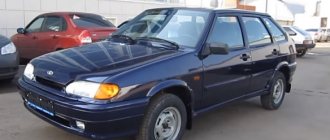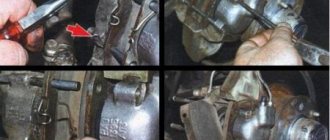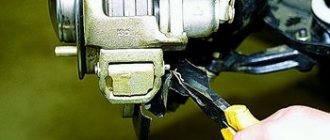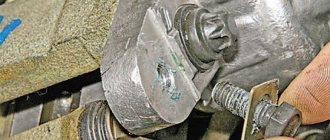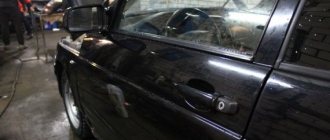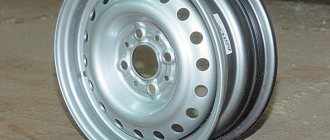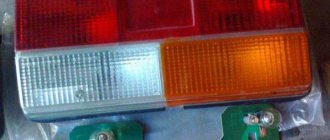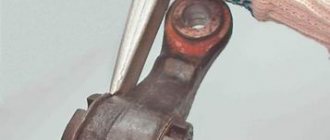Brake pad material
The requirements for the material from which brake pads are made are extremely contradictory, and the service life and efficiency of the finished product largely depend on a successful compromise between the properties:
- Heat resistance: When braking hard, a huge amount of kinetic energy is converted into heat. The brake pad should not change its properties during heating and transfer heat to the substrate and then to the brake
mechanism as quickly as possible. When the surface overheats, low-quality products appear “glassy” - the working surface becomes covered with a hard and slippery crust, which significantly reduces braking efficiency. To combat this, sports cars and motorcycles use drilled brake rotors, which clean the surface of the pads (but accelerate their wear). Regular cars have a smooth surface on the brake discs, but the glazing of the pads is much more dangerous for them. - Durability: the device should not crack or wear out quickly. Typically, the lining material is reinforced with copper or brass shavings; less commonly, steel and plastic materials are used. The reinforcement makes the device more durable and improves thermal conductivity, but at the same time increases wear on the disk.
- Abrasive action: The friction of the pads on the brake disc is necessary for the brakes to work, but at the same time leads to abrasion of the disc itself. Here you need to find a compromise: you can’t reduce friction too much, but frequent replacement of discs will not please the car owner.
Uneven wear of brake discs
Is Bosch as good as they make it out to be?
Probably, the first answer to the question about the best pads for many motorists would be Bosch. Indeed, we all know the quality equipment of this manufacturer well and understand its advantages very well. In auto parts, this company has proven itself to be excellent and has become one of the best brands in the whole world. But Bosch pads are not produced at a factory in Germany, and their quality today is not much different from budget solutions with a price tag half as low. There are such features of this product:
- the quality in reality is no longer proven by the tests that Bosch previously carried out for all its equipment; production in China has greatly damaged the reliability of the products;
- braking coefficients in independent tests specifically for Bosch equipment often do not fit into any framework, which clearly interferes with the normal operation of the car;
- the braking time on the heated pads of this corporation (in the budget class) increases to unlimited values, so it’s worth thinking about the feasibility of spending;
- the quality of the materials used directly depends on the price of the product, and the cheapest Bosch pads are not made from the most reliable raw materials, which leads to problems;
- When braking, you can hear a constant squeal and an unpleasant grinding sound - such elements of the braking system can easily damage the original brake disc.
The legend that all Bosch spare parts are of the highest quality, reliable and successful is not justified. Experts are increasingly abandoning these products and moving to products from specialized brands. So the time has come to change your policy regarding the purchase of spare parts. However, in the Bosch model line there are expensive pads suitable for VAZ. They fully justify themselves and turn out to be durable.
How to choose gaskets?
The appearance and markings of gaskets can tell a lot about them. In particular, the marking must indicate the coefficient of friction, designated by two letters (averaged during heating - the first letter, averaged after cooling - the second). Unfortunately, this is not always possible to find:
Source
The brake system of a car must always be in good technical condition, and this primarily applies to the brake pads. In the VAZ "Seven" they rarely have to be changed, and the main reason for this is wear of the friction lining. Problems with the brake mechanisms are indicated by appropriate signs indicating the need for inspection and repair or replacement of the brake elements.
READ Which Bridge Will Suit a VAZ 2107
Brake pads VAZ 2107
The basis for the safety of any car is the braking system, in which the brake pads are the main component. The purpose of the pads, their types, malfunctions and replacement for the VAZ “Seven” will be discussed in more detail.
What are they for?
Today, almost all cars use the same braking systems, based on a friction-based operating principle. The basis of this system is special friction mechanisms located on each wheel. The rubbing elements in them are brake pads and brake discs or drums. The machine stops under the influence of blocks on the drum or disk using a hydraulic drive.
Which
On the seventh model Lada, the brake pads have a design difference, since there are disc and drum brakes at the front.
Front
The brake mechanism of the front part of the car is equipped with pads with catalog number 2101-3501090. The element has the following dimensions:
- Length 83.9 mm;
- Height - 60.5 mm;
- Thickness - 15.5 mm.
The front brake elements on all classic Ladas are installed the same way. The manufacturer and supplier of original front covers for the VAZ conveyor is JSC TIIR.
The design of the front brake mechanism is quite simple and consists of the following elements:
- Brake disk;
- Support service;
- Two working cylinders;
- Two gaskets.
Video: Front Brake Pads VAZ 2107 Which are Better
The condition of the pillows should be checked periodically to ensure that the thickness of the pillows is at least 2 mm. If the friction material is thinner, the gaskets must be replaced.
Rear
For drum brakes, use pads with article number 2101-3502090 and the following sizes:
- Diameter - 250 mm;
- Width - 51 mm.
The original product was manufactured by AvtoVAZ OJSC. Like the front, the rear pads are suitable for any classic Lada model.
Brake
The rear axle mechanism has a simple drum design that works to expand. It consists of the following elements:
- Drum;
- Brake slave cylinder;
- Gaskets;
- Parking brake lever
What's better
When choosing brake elements, you should not skimp. In addition, it should be borne in mind that the design of the “seven” brake mechanism does not contain modern systems that would increase the level of safety. Therefore, the goods in question should be purchased in accordance with the following indicators:
- The optimal friction coefficient according to GOST is 0.35-0.45;
- Minimal impact on brake disc wear;
- Large resource pads;
- There are no extraneous sounds when braking.
If we consider brake pad manufacturers, then for active driving we should give preference to ATE, Ferodo. For a more relaxed driving style, when overheating and heavy loads on the braking system are not expected, you can buy Allied Nippon, Finwhale, TIIR. When purchasing a brake element, you should pay attention to the composition from which the friction lining is made. If the block is made using large metal shavings, which is noticeable by characteristic inclusions, the brake disc will wear out much faster, and it will remain a characteristic depression.
READ How to Remove the Front Axle of a Suzuki Grand Vitara
Metal pads.
Up to 65% of this type of pads are made of metal.
Advantages:
- Conducts heat well.
- Withstands the harmful effects of high temperatures.
- The coefficient of friction in such pads is higher than in others.
- They have a long service life.
However, it should be noted that metal pads are more suitable for heavy vehicles. Also, their loud braking may be unpleasant for some drivers. High cost is also included in the list of their disadvantages.
Useful and interesting: Required list of documents to apply for a cash loan secured by a car
Problems with brake pads
Brake parts
systems should be replaced not only when they wear out, but also when there are problems with poor-quality consumables or excessive movement. The occurrence of problems with gaskets is characterized by characteristic features:
- Creaking, rumble and other extraneous sounds when braking;
- The car slips when you press the brake pedal;
- To operate the pedal, you must exert more or less force than usual;
- Pedals while braking;
- After releasing the pedal, it does not return to its original position;
- Presence of black dust on wheels.
Extraneous sounds
Modern brake pads are equipped with special indicators that indicate wear on these parts. The indicator is a metal strip that is fixed under the friction lining. When most of the material has worn off, but the unit is still able to slow down, a characteristic cracking or whistling sound occurs when you press the brake pedal. If the pads are not equipped with such indicators, the presence of extraneous sounds indicates obvious wear of the brake mechanism elements and the need to replace them.
Skidding
If the car moves in one direction while braking, the likely cause is that one of the pads is worn out. The machine can roll even on dry surfaces. In addition to the pads, slipping can occur due to clogged or warped brake discs.
Video: why the car slows to the side when braking
Some time ago I was faced with a situation where the car began to veer to the side when braking. We didn't have to look long to find the reason for this behavior. After a quick inspection from underneath the vehicle, it was discovered that one of the rear brake wheel cylinders was leaking. This caused brake fluid to enter the working surface of the pads and drum, as a result of which the mechanism could not perform its function. The problem was resolved by replacing the cylinder and bleeding the brakes. If you have a similar situation, I recommend replacing the entire cylinder rather than installing a repair kit, because the quality of rubber products today leaves much to be desired.
Increase or decrease pedal effort
If you have to press the pedal unusually hard or lightly, the problem may be caused by abrasion or dirt on the pads. If everything is in order with them, you should check the integrity of the entire brake system for fluid impregnation.
READ Replacement Rear Drum Brake Pads Peugeot 406
Vibration
If vibration occurs when you press the brake pedal, a possible reason is that dirt has gotten between the brake disc and the pads, or there is a crack or chip in the latter. As a result, parts are subject to premature wear. However, it should be remembered that a similar phenomenon is also possible in the event of a malfunction of the hub or hydraulic cylinders of the brake system.
Wash pedal
Sometimes it happens that the brake pedal does not move back when pressed. This indicates that the pads are stuck on the disc. You can observe this phenomenon in sub-zero temperatures when the gaskets have become wet. Additionally, air can get into the brake system, requiring inspection and further repair or brake flushing.
Disc plate
The coating on the wheels is black dust, which indicates wear on the pads. If there are metal particles in the dust, then not only the pads are worn out, but also the brake disc itself. If such a situation arises, there is no need to intensify the inspection of the brake mechanism, as well as replace faulty parts.
One day I noticed that the front wheels were covered in black dust, and it was not road dust. It is unknown what brake pads were installed at that time, but after replacing them with factory ones from AvtoVAZ, the situation did not change. Therefore, I came to the conclusion that the appearance of black dust is normal and indicates natural wear of the gaskets.
